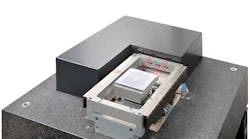Researchers at Philips Applied Technologies have developed an innovative technique that allows standard linear motors to simultaneously provide movement along two axes rather than along a single axis. This will allow designers to produce designs that achieve higher accelerations and operating speeds due to the reduced mass of the moving parts. It can also significantly lower equipment costs.
“The beauty of this new innovation in linear motor operation is that it requires absolutely no modification to existing motor components,” says Dr. Georgo Angelis, Senior Scientist at Philips Applied Technologies. “All you need to do is reposition the components slightly and drive them in an intelligent way.”
This simplified hardware aspect of the technology leverages the properties of conventional ironless multiphase linear motors. Specifically, the current-carrying conductors in conventional linear motors are arranged in coils and placed in a magnetic track, with only the vertical sides of the coils placed within the magnetic field. This arrangement limits the direction of the Lorentz force produced in the coils—and thus the motion of the coils—to the horizontal direction along the length of the magnetic track. However, in NForcer technology, the position of the coils with respect to the magnet track is shifted so that the lower horizontal section of the coils also sits in the magnetic field.
This repositioning allows the coils to generate a Lorentz force in the vertical as well as the horizontal direction with respect to the magnetic track. As a result, a single linear motor can produce swift, two-dimensional motion, such as that needed for pick-and-place machines (click here to download a video demonstration).
For example, in equipment such as the pick-and-place machines used to assemble pc boards, the technology will allow designers to reduce the number of motors and electronic drive modules required, as well as simplifying overall mechanical design. Philips has developed a pick-and-place demonstrator based on the technology that achieves 20-cm horizontal movement, and 3-cm vertical movement.
In addition to generating both the lift and the lateral motion required in pick-and-place machines with only a single linear track and a single forcer (consisting of three coils), the technology also enables precision magnetically levitated platforms using only four horizontal magnet tracks and six forcers (see Figure 1). These fully floating, magnetically levitated platforms provide a long-stroke x-axis, short-stroke y- and z-axis movements, and a few milli-radians of tilt and turn. Furthermore, unlike air-bearing solutions, they can function in vacuum.
Of course, magnetic levitation also eliminates the need for mechanical bearings, allowing NForcer technology to provide nanometer resolution. However, to provide this resolution, the other requirement is the ability to accurately sense the platform’s position. According to Philips, one way to accomplish this is through the use laser interferometry. For less demanding applications, simpler sensors can be used, such as encoders or optical sensors.
In keeping with the simplified hardware requirements for this technology, the software needed to drive the forcers is also highly compatible with existing techniques. According to Phillips, a new commutation algorithm for the vertical motion is simply added on top of the one used to control horizontal direction. A superposition of the two sinusoidal commutation laws (which are shifted with respect to the magnetic field) then describes the currents running through the three coils.
While the physical configuration of the forcer within a magnetic track resembles that of a magnetically levitated train, Philips states the control software algorithms for NForcer technology are proprietary to Philips. Still the technology will have great potential beyond the industrial applications mentioned here.
For example, Philips states the technology could be extended to serve as bearings for rotating machines or vehicle engines. In principle, it could even be used to provide lateral guidance in a magnetically levitated train.
